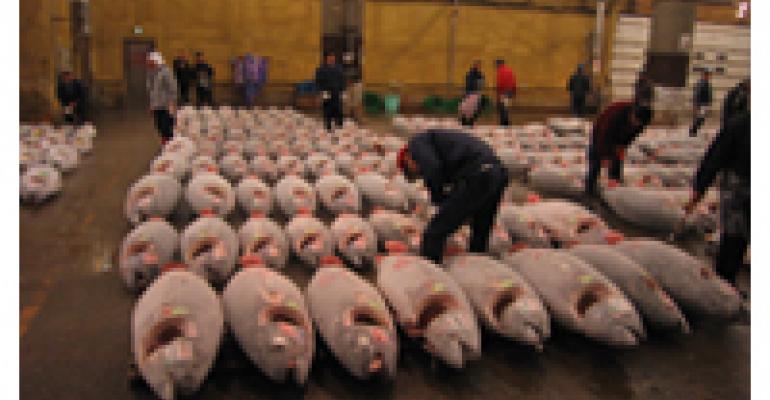
The legendary Tsukiji fish market in Tokyo is the epicenter of the world’s seafood supply, famous for its early morning auctions of wildly expensive and highly prized bluefin tuna. Now two Canadian restaurateurs have shown their fellow operators a way to bypass Tsukiji and buy bluefin direct, dramatically reducing their costs and reaping a publicity bonanza as part of the process.
Why doesn’t everyone do this? There are several caveats.
One is that even buying direct from the boat, bluefin tuna are expensive. You’ll need a lot of cash. Calgary, Alberta operators Maurizio Terrigno, of Osteria de Medici, and Zen 8 sushi restaurant owner Aki Fujita had to jointly come up with $25,000 to purchase their single bluefin earlier this month. This amount allowed them to outbid Japanese buyers who usually purchase the bluefin caught off Eastern Canada’s coast during the tightly controlled Prince Edward Island fishery opening (only five fishing days per year). Japanese buyers then fly the fish directly to Tokyo, where it goes on auction at Tsukiji.
A second issue is that, dockside, bluefin tuna are sold whole, not by the piece or pound. And you can’t spec a particular size; you have to take what was caught that day. In this instance, the Calgary restaurateurs found themselves bidding on a single 1,200-pound fish. That’s a lot of frutti di mare, tuna steaks and sushi to sell, no matter how great the raw product might be.
A third challenge: when you buy a 1,200-pound fish: you have to find someone capable of handling, breaking down and storing a fish of this size and quality. Luckily, such a fishmonger was available in Calgary.
All of which tells you how the two restaurant owners were able to circumvent the usual bluefin distribution channels. Similarly inclined operators would be advised to follow their lead and create a one-shot fish-buying cooperative, for both financial and logistical reasons. The benefits are mighty if you do.
For one, you save on the airfreight built into the U.S. price of a bluefin (or more likely, piece of bluefin) caught just a little north of Maine and shipped around the world and back before it lands in a U.S. restaurant. Also, depending on your dockside negotiating skills, you’ll likely save a bundle on the fish itself. The record price this year for a bluefin at Tsukiji is $125,000 for a smaller (282 pounds) and much rarer Japanese bluefin.
But selling the fish off your menu should be easy, because the media will do most of the marketing for you. The Calgary duo got a heavy dose of local and national coverage, because as food news goes, this was stop-the-presses material.
“If you want the best, you’ve got to pay for it,” Terrigno told the Canadian Press, explaining that he’d been bidding on bluefin for years before finally landing one this year.
Fujita underscored what a rare opportunity this move provided Calgary-area sushi lovers. “This fish is healthy food and it’s so much better than any other kind,” he said. “We don’t call it the king for sushi or sashimi making; it’s the emperor.”
If you believe that the secret to success in the restaurant business is offering customers something your competitors don’t have, here’s a way to cash in big time. If you’re into sustainable seafood, however, you may want to take a pass on bluefin tuna. One reason they’re so expensive is that severe overfishing has made them increasingly scarce.
So how did this venture go for Terrigno and Fujita? Let’s just say that these two plan to return to Prince Edward Island this fall for the next opening of the bluefin tuna fishery, scheduled for October.





